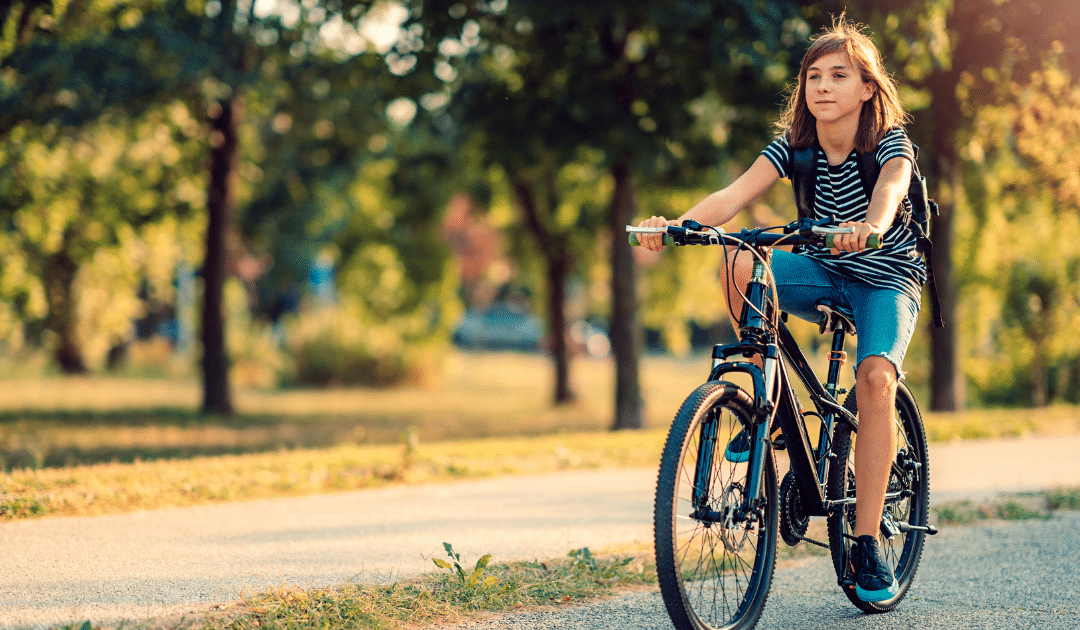
by California Casualty | Educators, Safety |
Letting go is one of the hardest things we can do as parents. After all, we want to be there every step of the way—and that includes making sure our children get safely to school and home again.
But there comes a time when we step back, and send them on their way with pride (and just a little anxiety). How do we know when the right time is? Here’s some guidance on determining when and how to let your child walk or bike to school alone.
First, let’s remember the benefits.
Walking or biking alone to school is a milestone in growing up. It’s good for your child and it’s good for you. Here’s why.
-
- It’s great exercise. It helps keep your child moving every day.
- It gives your child a sense of independence and responsibility.
- It boosts your child’s self-confidence.
- It gives them a chance to follow rules and make good decisions.
- It allows bonding time with friends, including a chance to make new ones.
- It limits your family’s carbon footprint.
- It frees your time so that you can do something else.
How do you know if your child is ready?
Every child is different. And not every school route is the same. Taking into account your child’s age and maturity, and the difficulty of the route, you can make a determination. As their parent, you are the best person to know if your child is ready and if walking or biking to school is safe. If you live in an area of high crime, you may want to reconsider letting your child walk or ride alone.
If you’re looking for guidelines, healthychildren.org (from the American Academy of Pediatrics) notes that most children are not ready to walk or bike alone until the fifth grade or about age 10. That’s as long as they can follow rules, show good judgment, and not be easily distracted.
Prepare for the moment.
The important thing is you don’t have to jump right into having your child walk or bike alone to school. You can put in the necessary preparation to make sure that he or she will be able to do so safely. Here’s how you can prepare.
-
- Educate your child on street signs and what they mean. You can do this when you’re driving in the car as well as walking around the neighborhood.
- Establish and practice the rules for crossing the street. Look left, then right, then left again. Then, cross. Never cross in the middle of the block.
- Explain to your child that cars share the road with bikes and pedestrians. Show your child how to be aware of vehicles wherever they may be.
- Remind your child to stay on the sidewalk and out of the street unless crossing at a crosswalk.
- If biking, teach your child the bike safety
- Remind your child to walk his/her bicycle across intersections.
- Test the route by walking it with your child. Let your child lead the way so you are confident that he/she knows where to go.
- Practice locking and/or storing the bike at school.
Prepare for an emergency.
You want to prepare your child for any possibility from getting lost to getting a flat tire to stranger danger. Role-playing helps your child practice the skills needed.
-
- Point out the best people to ask for help if lost.
- Practice having your child walk his/her bike the whole way to school and back in the event of a flat.
- Educate your child to recognize and handle dangerous situations. Identify safe places along the route where they can go if they feel in danger.
All of these tactics will help keep your child safe wherever they are, and not just walking or biking alone to school.
When your child is ready to walk or bike to school without you, follow these tips.
-
- See if your child can walk or bike with a friend or group of friends. Some communities have started a walking school bus or bicycle train to help children travel safely.
- Consider getting your child a basic cell phone. Have your child check in with you when he/she arrives at school, and when he/she is leaving. However, make sure they know not to text while walking or biking. That will distract them from their surroundings and put them in danger.
- Brightly colored jackets and backpacks are most easily seen by cars, so dress your child accordingly.
- Before your child gets on his/her bike, check the air and tire pressure, and test the brakes.
- Have a backup plan for getting to school in inclement weather, such as riding the school bus.
This article is furnished by California Casualty, providing auto and home insurance to educators, law enforcement officers, firefighters, and nurses. Get a quote at 1.866.704.8614 or www.calcas.com.

by California Casualty | Auto Insurance Info |
You depend on your car, and your car depends on regular maintenance to keep it running smoothly. But sometimes it’s tempting to skip routine maintenance or put it off because of the cost or the inconvenience of being without your car. Don’t.
These common vehicle mistakes could cost you big time down the road.
Mistake #1: Skipping basic tire maintenance
Your tires are the only parts of your car that make contact with the road and they do it for thousands and thousands of miles. That’s why even basic tire maintenance goes a long way.
Rotate your tires: Tires don’t wear evenly. The front tires usually have more wear on the outside edges, because they lean when you turn right or left. The front tires also hold the weight of the engine. To help your tires wear evenly, you need to rotate them every 5,000-7,000 miles.
If you don’t rotate them, your front tires will wear out more quickly and you’ll need to replace them thousands of miles sooner.
Align your tires: If you’ve ever taken your hand off the wheel while driving, and notice your car veering toward the side, you need an alignment. You need to align your tires to keep them pointing straight ahead. You can easily knock them out of alignment by going over a pothole.
If you don’t align your tires, you can experience steering problems, poor fuel economy, and uneven tire wear.
Check tire pressure: You should also regularly check the tire pressure. If yours is a newer vehicle, it comes with a Tire Pressure Monitoring System (TPMS) which helps you know when you’re low.
An underinflated tire will increase your risk of a blowout.
Mistake #2: Ignoring your fluids
Your car relies on engine oil, coolant, brake fluid, transmission fluid, and power steering fluid. Fluids deteriorate over time and can get dirty, making them less effective and even corrosive. It’s important for all of these fluids to be at the right levels so they can do their job.
Change the oil: Engine oil keeps everything lubricated, but it gets dirty over time. Changing the oil regularly is important. It used to be that we changed the oil every 3,000 miles but if you’re using synthetic oil, you can go longer. Check your vehicle recommendations for the timeframe.
If you don’t change your oil, it can become so dirty that it doesn’t work. That will cause your engine to overheat, blow a gasket or seize up.
Check the coolant: Coolant, or antifreeze, keeps your engine from overheating or freezing. If your temperature gauge is running high, it’s time for a coolant flush. You also might notice a maple syrup scent that occurs when your car is burning through coolant and needs a refresh. You should have your coolant system inspected regularly; check your vehicle’s maintenance schedule.
Your engine could overheat or blow a gasket, necessitating major repairs. Dirty coolant also can cause corrosion.
Check the brake fluid: Brake fluid can last for years. But sometimes moisture can get into the sealed system and impact your ability to brake and cause corrosion. Get your fluid checked every couple of years.
If you don’t maintain your brake fluid, your brakes may feel spongy and it may take longer to come to a stop. Your brakes could even fail.
Change the transmission fluid: Transmission fluid lubricates the gears, cools them, and helps provide hydraulic pressure to make them work. Whether you drive a vehicle with a manual transmission or one that’s automatic will depend on how often you need fresh transmission fluid. Check your vehicle’s maintenance schedule.
If you don’t change your transmission fluid, you will have difficulty shifting gears and your transmission could overheat.
Look for leaks in the power steering fluid: Power steering fluid helps you turn the wheel easily. As long as there are no leaks, and your car’s manufacturer does not suggest changing the fluid, you’re probably fine to leave it be.
If there is a leak, and your fluid dips down, it will be hard to steer. Parts of your steering system could corrode.
Mistake #3: Waiting too long to replace your brake pads
Brake pads apply pressure on the rotors, which is what ultimately slows and stops your vehicle. How fast they wear depends upon your driving habits, your car’s make and model, and other factors. You might notice signs of your pads wearing out, such as a squeaking sound or a clicking noise when you brake. The brake pedal may vibrate when you brake. Perhaps it takes you longer to brake. Don’t wait for weeks or months after the first warning signs.
Without good working brake pads, the whole braking system could overheat and fail. It also could cause damage to the rotors.
Mistake #4: Ignoring noises or dashboard warnings
Sounds serve as warning signals. That’s why if you hear something new or unusual when you’re driving, pay attention. Here’s what some common sounds could mean:
-
- Hissing – leak in the cooling system or the vacuum system
- Clunking over potholes or bumps – faulty, loose, or worn parts
- Howling – bad bearings or worn gears
- Knocking – valve clearances need to be adjusted or rod bearings need to be replaced
- Shrieking – serpentine belt may be slipping or need to be replaced
- Moaning or growling – failure of the power steering pump
- Metallic rattling or pinging – abnormal ignition
- Crunching – clutch issues in a manual transmission
Also, don’t ignore the dashboard warnings. Those lights are there to give you an early indication that something needs to be addressed.
Waiting too long to address a noise or dashboard indicator gives the problem a chance to become larger and more expensive.
Mistake #5: Not following your car’s maintenance schedule
The most important thing you can do is to follow your car’s maintenance schedule. This schedule is specific to your vehicle and will help to avoid costly repairs. It increases safety, helps maintain your vehicle’s value, and ultimately saves you time. Just as preventive care keeps you healthy, this maintenance schedule keeps your car operating at peak performance.
Not following your car maintenance schedule could void your warranty, and you’ll be responsible for the expensive repairs.
Your vehicle is an investment. Protect it with the right maintenance and the right insurance.
This article is furnished by California Casualty, providing auto and home insurance to educators, law enforcement officers, firefighters, and nurses. Get a quote at 1.866.704.8614 or www.calcas.com.

by California Casualty | Homeowners Insurance Info |
You’ve bought a house. Congratulations! Now the fun begins. As a new homeowner, you’re going to be responsible for a lot more than when you were renting.
Follow these 7 money-saving tips to set up your new home like a pro.
Tip #1: Wait to spend on nonessentials. Fix things first.
Don’t worry about buying furniture, changing your cabinets, decorating or personalizing your home right away. Right now, your focus should be on repairing and replacing.
-
- Take care of any maintenance and repairs that you can do yourself, such as painting walls and replacing doorknobs and locks.
- Hire a qualified contractor for electrical work, plumbing, roof repair, gas appliances, and to handle any toxic materials like mold or asbestos.
- When choosing a contractor, get cost estimate quotes from three different providers. This will help you find the one that is most cost-effective.
- Make sure any contractors you use are licensed to work in your state. Ask for references and talk to some of their past clients.
Tip #2: Seal your home. Check your insulation and look for small air leaks.
Insulation is the material that keeps the heat in your home during the winter and the cool in during the summer. When you have the right amount of insulation, and no air leaks around openings like doors, it will help to lower your heating and cooling bills
-
- Check to see that you have at least six inches of insulation in your attic. You will need more in colder climates.
- Don’t forget to insulate around the attic opening. That’s a common place to lose heat.
- Wrap any exposed water pipes in insulation. This will help prevent frozen pipes.
- Caulk and weatherstrip to seal small air leaks around doors, windows, and electric outlets. These are all places where air can get in and out.
Tip #3: Regulate the temperature in your home.
Your home’s heating and cooling systems work to keep things comfortable—at a cost. You can help reduce those bills with a few simple adjustments.
-
- Install a programmable thermostat. This allows you to raise the heat while you’re at work and cool down when you are home during the summer months and vice versa for the winter.
- Lower the temperature on your hot water heater to 120 degrees F. Not only will it help with your energy bill, but it will also help prevent scalding burns.
- Install ceiling fans. This is a great way to move air around, and help reduce the amount of air conditioning you need.
- Close the blinds to block the sun which can heat up your house.
Tip #4: Watch for standing water or water leaks.
A sudden increase in your water bill is a sign that you probably have a leak. Keeping on top of these repairs is an easy way to prevent this unnecessary cost.
-
- If you have a dripping faucet, repair or replace it as soon as possible.
- Check under the sinks for wet spots that may indicate leaky pipes.
- If your toilet is constantly running, that could raise your water bill as well. You may need to replace a part such as a flapper, fill valve or chain.
- Check for a leaky toilet. Remove the tank lid and put a few drops of food coloring in the back of the tank. Wait 30 minutes without flushing your toilet. If you see the color in the toilet bowl within that time, you probably have a leak.
Tip #5: Take advantage of tax benefits and incentives.
As a homeowner, you may qualify for tax benefits and incentives if you itemize deductions on your tax return. Consider hiring an accountant to help you maximize your refund.
-
- Mortgage interest is deductible.
- Home equity loan interest is deductible if you spent the money on home improvements.
- You may get a tax break for paying property taxes.
- If you work at home, you can deduct home office expenses.
Tip #6: Pay off your mortgage early.
You can reduce the amount of interest that you pay if you budget correctly and pay off your mortgage early.
-
- Switch your mortgage to a biweekly payment. If your monthly payment is $1,000, pay half, $500, every two weeks. You will pay the same amount that you would, but will end up making 13 full payments instead of just 12 in a year. You also will rack up less interest, which is calculated daily. Overall, this will end up saving you thousands of dollars.
- Make extra principal payments when you send your monthly payments.
- Consider using any windfalls, such as your tax refund, as payments toward your principal.
Tip #7: Update your insurance.
Your home is likely your largest investment. Make sure it is protected with the right insurance.
-
- Your mortgage lender requires homeowner insurance. Many homeowners pay the mortgage lender who in turn pays the insurance company through an escrow account.
- Consider bundling your car insurance and homeowner insurance to save money.
- Make sure that you have disability income insurance so that you can continue to pay for your home in the event you are unable to work.
- If you live in an area that floods, consider adding flood insurance. Similarly, there is earthquake insurance.
- Consider an umbrella policy for extra coverage beyond your homeowner policy.
This article is furnished by California Casualty, providing auto and home insurance to educators, law enforcement officers, firefighters, and nurses. Get a quote at 1.866.704.8614 or www.calcas.com.

by California Casualty | Educators |
Going into your first year of teaching can be hectic. Even the most in-depth college education programs, might not prepare teachers for what their actual first year in the classroom may bring. First-year teachers can struggle with anything from lesson planning and classroom behavioral issues, to their own time management.
So, we’ve asked the best resource for first-year educators- our seasoned audience of teachers across the nation, to provide tips and advice to their new colleagues entering the field of education.
Here’s what they had to say.
- Stay Calm
– If something doesn’t go the way you planned, it may feel like the walls are closing in and you have chosen the wrong profession, but it’s not. Getting into a new routine and feeling comfortable takes time (yes, even with teaching). You’ve got this!
- Set Boundaries for Yourself
– Remember teaching is your job, not your whole life, try not to let a few late nights turn into months and years. Don’t feel guilty for separating yourself and your home life from your work life.
- A Gallon of Coffee a Day
– Keeps the doctor away, right?
- Brush up on Technology (especially Google classroom)
– Even if you are starting your first year in the classroom, it would be a good idea to get familiar with the technology your school is using for virtual learning- just in case. Plans change quickly and often, this way you will always be prepared.
- Take Time for Yourself Every Day
– Moments of peace and quiet are few and far between. Find time in your day for yourself; whether that be before school, during your planning period, or when you get home at night.
- Learn that it is Okay to Ask for Help
– You won’t have the solution to every problem and that’s okay. If you are struggling with something (even if it’s just the copier) learn that asking for advice from your peers is completely normal and usually encouraged.
- Playing Can Be Learning
– If you have a class that reacts more to hands-on or interactive activities, don’t be afraid to adjust your lesson plans to help incorporate more activities like this. Learning can be fun!
- Listen to Music in the Classroom
– It is YOUR classroom and you decide how it will be run. If you discover having your kids sit on exercise balls and listen to calming tunes while they’re working is conducive to their learning experience- then do it!
And the fan-favorite….
- Stock up on Your Favorite Beverages!
– This one speaks for itself! However, if you’re solely a black coffee and water-only drinker, the important point here is that you should find a way (that works for you) to unwind and relax when you get home from school.
When that first day of school rolls around, don’t stress out. We’ve all been there! And if you’re having doubts, just remember why you went into the education field in the first place.
You can do this! Have a great first year.
This article is furnished by California Casualty, providing auto and home insurance to educators, law enforcement officers, firefighters, and nurses. Get a quote at 1.866.704.8614 or www.calcas.com.

by California Casualty | Firefighters, Peace Officers, Safety, Travel |
You hear sirens and see flashing lights. There’s only one thing to do. Pull over.
There’s a reason you’re moving out of the way.
Even a few minutes delay can be a matter of life and death when you’re traveling by ambulance. The same holds true if a first responder can’t get to the scene of an accident, a fire, or disaster. Emergency vehicles need to get to the place where they can help people. If you’re on the road where they are traveling, you can help them get there by giving them a clear path to their destination.
Your moving car is dangerous to stopped vehicles.
You may have noticed a police officer, a roadside worker, a car pulled over on the side of the road, or even a wreck. Driving by them or rubbernecking at high rates of speed is dangerous. According to the National Highway Safety Administration (NHTSA), “making a traffic or emergency stop on the side of our nation’s highways is one of the most dangerous things law enforcement officers do in the line of duty.”
Every two weeks, a first responder or roadside worker loses his/her life, reported AAA. The agency recommends slowing down to a speed that is 10-20 mph slower than the speed limit and changing lanes to be further away.
Pay attention so you’ll hear and see emergency vehicles.
If you have the radio blaring, if you’re texting, or otherwise distracted, you may not see or hear an emergency vehicle approaching. You might not know that you have to pull over until that vehicle is right there. Not only is that stressful, but your quick actions might also cause a collision.
Here’s what to do when you see lights and hear sirens.
-
- Put on your turn signal and slow down.
- Check your mirrors and make sure the way is clear.
- Move over to the shoulder and park your vehicle.
- Wait until the emergency vehicle has passed. You will want to stay at least 500 feet behind it.
- Check your mirrors, put on your turn signal and carefully pull back into traffic.
Importantly, don’t slam on your brakes. Don’t travel through a red light. Don’t stop in the middle of your lane. And never try to outrun an emergency vehicle.
Where you are, and the direction you’re traveling, matter.
Emergency vehicles don’t always come from behind you. Sometimes they are traveling in the opposite direction, on the other side of the road. Do you still have to move over? Check your state laws for the rules regarding moving over for emergency vehicles.
-
- If you are traveling in a high-speed lane, and there is no room to stop, slow down.
- If you are traveling in the left lane, go right as traffic on the right moves over.
- If you are stopped at an intersection, stay there.
- If the emergency vehicle is traveling on the opposite side of a divided highway, you don’t need to pull over.
- If the emergency vehicle is traveling on the opposite side of the road, and there is no divider, pull over to your right. That vehicle may need to use your lane to get by.
Every state in the U.S. has a move-over law. Most people don’t know about it. Check your state’s law and learn what you need to do to keep everyone safe.
This article is furnished by California Casualty, providing auto and home insurance to educators, law enforcement officers, firefighters, and nurses. Get a quote at 1.866.704.8614 or www.calcas.com.





